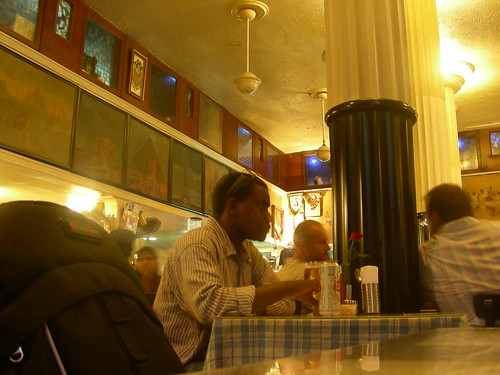Circa 1915. These are turbulent times. With the movement for self-rule gathering pace, Lokmanya Tilak had become the uncrowned leader. Tilak professed social as well as political revolution. Many amongst the orthodox upper-caste people in Pune are dead opposed to the newly emerging social structure. In the midst of all this, live the Sarafs, a Chitpavan Brahmin family, in a typical joint family setup in their ancestral wada. Being educated and socially as well as politically conscious, the family is exposed to all that is happening around them. The head of the family, Aaba, is orthodox enough, but not oblivious to the winds of change. He tries to carefully balance the traditional setup, while welcoming the new changes.
The story begins with Dada and Vahini's wedding ceremony. As was common in those days, Dada's mother, Mai, delivered twins, Bal'Baban(son) and Mohana(daughter) a few days after Dada's marriage. But the pregnancy took its toll on her and Mai dies, leaving the few months old twins in Vahini's care. Being the eldest lady of the house, it is now Vahini's duty to carry on all the duties that are required from the lady of the house. Vahini carries on all the duties without any cribbing. Though educated upto university level, she is devoted to her husband and upholds all the traditional values of the family. Aaba has an unscrupulous brother, the Jahagirdar, who has abandoned the family, but comes back to stake his claim in the family matters.
In Transit covers the life of this Chitpavan Brahmin family when the entire social fabric of the country is undergoing a reforming change. It is a story of how this large family manages to live together, despite having extremely conflicting views about politics and society. Aaba, although ambivalent, isn't oblivious to the changes around him. The Jahagirdar wants to protect all the old traditions of the Hindu society and therefore hates the freedom struggle, its leaders and anybody who professes social reform. Dada, the eldest son, prefers to side with the British system of education and sees it as the only road to prosperity. But Dada does believe in social reform, like his father. Daji, is undecided and he neither favours nor hates the freedom movement. Bhayya is strongly influenced by Tilak, and later by Gandhi. Aaba, sensing Bhayya's strong devotion towards the national cause, takes Bhayya under his wings and trains him to follow the path of his choice. Lopamudra, the daughter of the house, sides with her husband, a staunch Gandhian. Bal'Baban becomes a follower of Bhayya, because that is what he did since his young days. All of them are tied together with the bonds of affection towards each other and especially towards Aaba and Vahini.
Vahini is deceptively strong in her convictions. Although she appears to be the obedient daughter-in-law of the house, upholding its traditions, she is alert to the changing winds and realises the steps that should be taken to preserve the well being of the next generation. She is extremely possessive about the childrens' well being and her husband's pride. She is prepared to sell-off the family silver and gold in order to get good education for the children. She is the one, along with Aaba, who are the sole reason for the family to be tied together. Mohana, the youngest daughter of the house, is an interesting character. Although a delicate mindset, she too is strong about her convictions. As the story progresses, you may get emotionally attached to Mohana and her tryst with her destiny.
The novel beautifully captures the effects and influences of the traditional Pune society on the childrens' mindset. The uneasiness felt by Mohana on first hearing a Bombay bride calling her husband by name, the make-up and sleeve-less bodices worn by Bombay girls is captured very nicely. When she realises that she is in love with Madhav, Vahini's brother, her emotions are worth feeling. Even Madhav's restlessness is typical of the mindset of the people of that era. The uneasiness felt by the love birds in the presence of the other, having little Leelavati for company, even during the little courtships that were possible is wonderful to read.
Apart from this micro details, the story is about how the Saraf family manages the transitional period in their lives, shifting from a spacious wada to a small room in Mumbai and then getting back to the wada, sans their riches. The effect of the political struggle on the family, the family's readiness to allow its members to follow their convictions, as long as they are right and its readiness to stand by each other even in the case of crisis and crack-downs, is worth reading. It also highlights the struggle at individual levels, about many things that we take for granted today. E.g., the opening of school for girls. This causes an uproar in the family, when the old orthodox members vehemently oppose sending the girls to school. Today, grooms require that their wife be educated to the best possible extent, but back then, a university educated girl meant that she would cause havoc in the family. Because, she is more likely to resist traditions and more individualistic. All in all, the story is well paced, although some details may bog you down sometimes. The ending, though, is abrupt and the story doesn't culminate properly.
About Venu Chitale: Venu Chitale was a news announcer with BBC during the second world war. She published this novel in 1950, which carries a foreword by Pune University's first Vice Chancellor, M. R. Jaykar and a special mention by her BBC colleague Mulk Raj Anand. She has also published two more novels that I know of, In Cognito(English) and Bablya(Marathi). She is widely recognised as the first woman of Marathi origin to write an English novel. In Transit has been published by Hind Kitabs. I found this book in IIT Bombay's library.
The story begins with Dada and Vahini's wedding ceremony. As was common in those days, Dada's mother, Mai, delivered twins, Bal'Baban(son) and Mohana(daughter) a few days after Dada's marriage. But the pregnancy took its toll on her and Mai dies, leaving the few months old twins in Vahini's care. Being the eldest lady of the house, it is now Vahini's duty to carry on all the duties that are required from the lady of the house. Vahini carries on all the duties without any cribbing. Though educated upto university level, she is devoted to her husband and upholds all the traditional values of the family. Aaba has an unscrupulous brother, the Jahagirdar, who has abandoned the family, but comes back to stake his claim in the family matters.
In Transit covers the life of this Chitpavan Brahmin family when the entire social fabric of the country is undergoing a reforming change. It is a story of how this large family manages to live together, despite having extremely conflicting views about politics and society. Aaba, although ambivalent, isn't oblivious to the changes around him. The Jahagirdar wants to protect all the old traditions of the Hindu society and therefore hates the freedom struggle, its leaders and anybody who professes social reform. Dada, the eldest son, prefers to side with the British system of education and sees it as the only road to prosperity. But Dada does believe in social reform, like his father. Daji, is undecided and he neither favours nor hates the freedom movement. Bhayya is strongly influenced by Tilak, and later by Gandhi. Aaba, sensing Bhayya's strong devotion towards the national cause, takes Bhayya under his wings and trains him to follow the path of his choice. Lopamudra, the daughter of the house, sides with her husband, a staunch Gandhian. Bal'Baban becomes a follower of Bhayya, because that is what he did since his young days. All of them are tied together with the bonds of affection towards each other and especially towards Aaba and Vahini.
Vahini is deceptively strong in her convictions. Although she appears to be the obedient daughter-in-law of the house, upholding its traditions, she is alert to the changing winds and realises the steps that should be taken to preserve the well being of the next generation. She is extremely possessive about the childrens' well being and her husband's pride. She is prepared to sell-off the family silver and gold in order to get good education for the children. She is the one, along with Aaba, who are the sole reason for the family to be tied together. Mohana, the youngest daughter of the house, is an interesting character. Although a delicate mindset, she too is strong about her convictions. As the story progresses, you may get emotionally attached to Mohana and her tryst with her destiny.
The novel beautifully captures the effects and influences of the traditional Pune society on the childrens' mindset. The uneasiness felt by Mohana on first hearing a Bombay bride calling her husband by name, the make-up and sleeve-less bodices worn by Bombay girls is captured very nicely. When she realises that she is in love with Madhav, Vahini's brother, her emotions are worth feeling. Even Madhav's restlessness is typical of the mindset of the people of that era. The uneasiness felt by the love birds in the presence of the other, having little Leelavati for company, even during the little courtships that were possible is wonderful to read.
Apart from this micro details, the story is about how the Saraf family manages the transitional period in their lives, shifting from a spacious wada to a small room in Mumbai and then getting back to the wada, sans their riches. The effect of the political struggle on the family, the family's readiness to allow its members to follow their convictions, as long as they are right and its readiness to stand by each other even in the case of crisis and crack-downs, is worth reading. It also highlights the struggle at individual levels, about many things that we take for granted today. E.g., the opening of school for girls. This causes an uproar in the family, when the old orthodox members vehemently oppose sending the girls to school. Today, grooms require that their wife be educated to the best possible extent, but back then, a university educated girl meant that she would cause havoc in the family. Because, she is more likely to resist traditions and more individualistic. All in all, the story is well paced, although some details may bog you down sometimes. The ending, though, is abrupt and the story doesn't culminate properly.
About Venu Chitale: Venu Chitale was a news announcer with BBC during the second world war. She published this novel in 1950, which carries a foreword by Pune University's first Vice Chancellor, M. R. Jaykar and a special mention by her BBC colleague Mulk Raj Anand. She has also published two more novels that I know of, In Cognito(English) and Bablya(Marathi). She is widely recognised as the first woman of Marathi origin to write an English novel. In Transit has been published by Hind Kitabs. I found this book in IIT Bombay's library.








